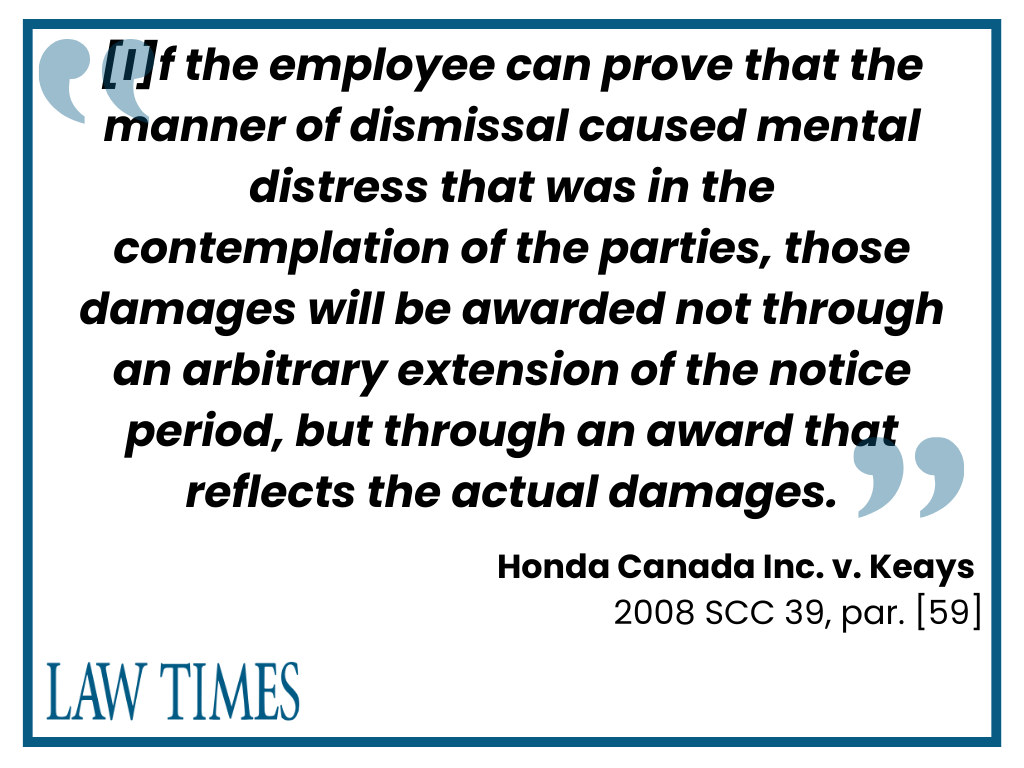
Counsels may wonder if Wallace damages are still applicable to Ontario’s common law or if the damages can still be awarded for wrongfully dismissed employees

Old precedents and case law may still have certain effects on the court decisions of today. One perfect example of this is what's referred to in labour and employment law as Wallace damages. The question is, after modern rulings against it, is it really now dead? We’ll tackle this question and more in this guide.
This article can be used by lawyers, especially in the practice area of labour and employment. Although this is also for those who are not in the practice area but are faced with a claim involving the Wallace damages.
The Wallace damages originate from the 1997 decision of the Supreme Court of Canada (SCC) in Wallace v. United Grain Growers Ltd., [1997] 3 SCR 701. Wallace held that employers are liable for bad faith and unfair dealing over the way in which employees were dismissed. Where the employer engaged in such conduct, the courts could add to the length of the reasonable notice period. This conduct of bad faith and unfair dealing could include untruthful, misleading, or unduly insensitive behaviour.
At the heart of awarding Wallace damages are the “humiliation, embarrassment and damage to one's sense of self-worth and self-esteem” that the employee suffered. However, such feelings (which can now be equated to moral damages) must be related to the employer’s “bad faith conduct or unfair dealing in the course of dismissal.”
This decision teaches us that — which must have been and must always be the standard — employers are bound to exercise good faith and fair dealing when dismissing an employee. While each circumstance may vary, managers and HR professionals are reminded to always act in good faith. Otherwise, damaging results can blow a simple task like letting an employee go out of proportion.
However, another landmark case which has changed the way that Wallace damages are now awarded is the case of Honda Canada Inc. v. Keays, 2008 SCC 39. The 2008 decision said that courts cannot arbitrarily extend the notice period when the employer is found to have been in bad faith in dismissing the employee. Instead, the employee now has the burden of proving both:
Here’s a summary of the recent developments to the Wallace damages after the Keays decision:
Lawyers can seek out colleagues in the field of labour and employment law for more on the Wallace damages. This Special Report from Canadian Lawyer Magazine, one of our sister publications, on the Top Labour and Employment Law Firms in Canada is helpful.
Many employment lawyers saw Keays, also a SCC decision, as the death knell, or something close to it, for damages outlined in Wallace.
Since 1997, Wallace pleadings have been a staple of wrongful dismissal cases. But in 2008, the majority ruling in Keays stated that Wallace damages don’t apply to normal distress and hurt feelings resulting from dismissal. Rather, employees would receive redress only if they could show that the manner of dismissal caused mental distress that was in the contemplation of the parties.
According to the Keays decision, conduct capable of attracting such awards included “declarations made at the time of dismissal, misrepresentation regarding the reason for the decision, or dismissal meant to deprive the employee of a pension benefit or other right, permanent status.”
Furthermore, such awards couldn’t be arbitrary but had to reflect the actual damages. As such, the damages that previously refers to Wallace damages are no longer awarded to extend the notice period. Rather, it may be considered as aggravated damages instead.
But if Keays poured water on the Wallace fire, the Ontario Court of Appeal’s decision in Slepenkova v. Ivanov, 2009 ONCA 526 has at the very least turned the water pressure down. Here, the ONCA upheld the trial judge’s award of two months’ pay in Wallace damages.
“The trial judge made a specific finding that the appellant’s pager message to other agents informing them ‘that [Slepenkova] failed to adequately perform her duties was unfounded and damaging to her reputation,’” the court stated.
“In our view, this finding of fact was sufficient to sustain the Wallace award, even in light of the Supreme Court of Canada’s decision in [Keays]...which was rendered after the trial judge’s decision in this case.”
On its face, Slepenkova appears to challenge Keays in two respects:
Sue Sorensen, now an Employee Relations Consultant at Macquarie Group, said in a 2009 interview that she was surprised by the Slepenkova ruling. “It’s shocking. Since when does stare decisis not apply?”
The fact that the trial judge decided the case before the high court released Keays may account for the ONCA’s refusal to interfere with the extension of the notice period. This is according to Mark Josselyn, a Partner at Gowling WLG, in an interview in 2009.
“It would have been easy enough for the Court of Appeal to say that the trial judge should have made a specific dollar award related to the actual damages rather than just adding on two months’ pay,” Josselyn said. “But that’s exactly what he did, because two months of pay were worth about $10,000 to the plaintiff.”
The point is that regardless of how you express the award, the appeal court clearly believed the employer’s behaviour merited it. “The judge said the allegations about Slepenkova’s performance was unfounded and that the termination was a tool by which the company hoped to persuade its agents to sign certain agreements,” Josselyn said.
Jeff Goodman, an Employment Law Partner at Mathews Dinsdale, is of similar mind. “The court in Keays didn’t say that employers shouldn’t be punished for bad faith behaviour,” he said in a 2009 interview. “It merely changed the basis on which damages for such behaviour could be awarded by tying it to the plaintiff’s actual damages.
“The Slepenkova court probably felt that it wasn’t worth going through the mechanics of converting from months to dollars given that the trial decision preceded [Keays] and that from a practical perspective the result would have been virtually the same.”
Related to the finding of bad faith during termination is the topic of dismissal with or without cause. More about it with this video:
Looking for colleagues in employment law to consult with? Use this directory of the best employment lawyers in Ontario as ranked by Lexpert, another sister publication of Law Times.
The “actual damages,” according to the appeal court, came out of the trial judge’s finding of injury to Slepenkova’s reputation. By contrast, in Nikolova v. Ivanov, which involved Slepenkova’s co-worker, the court refused to uphold the Wallace damages because there was no similar message in her case “nor was there any other evidence that she suffered harm, mental distress or actual damage.”
Still, Josselyn expects the courts will be harder on plaintiffs after Slepenkova. “Once the appeals of trial decisions that predate [Keays] work their way through the system, judges will not be tacking on months arbitrarily but will be seeking evidence of real mental distress,” he said.
The need to prove actual damages, Josselyn added, could well complicate wrongful dismissal cases. “It wouldn’t surprise me if plaintiffs’ lawyers started sending their clients off for medical opinions. But that will make the litigation more expensive, and I’m not sure it will help plaintiffs overall.”
For his part, Goodman doesn’t believe medical evidence will always be necessary. “Where there’s an intentional infliction of mental suffering, I don’t think courts will hesitate to award damages without testimony from doctors.”
Arguably, that’s precisely what happened in Slepenkova. “I think some people on the defence side were too optimistic about [Keays’] impact,” Goodman said. “We’ll still see Wallace damages but expressed in different terms and requiring proof of something that amounts to actual damage.”
The difficulty with Wallace, according to Goodman, is that it created a two-tier system. “A two-month extension of a notice period is worth a lot more to a senior executive than to an assembly line worker where both have suffered roughly the same amount of harm. Wallace damages are not dead. It’s just that we won’t be seeing the extraordinary awards that have benefited some big earners.”

While the debate continues whether Wallace damages is dead or revived, one thing’s for sure: bad faith conduct is still a compensable act when it comes to wrongful dismissals.
Recent court decisions show that the remnants of Wallace damages are still here — in the form of exemplary, moral, or “bad faith damages.” Designations may differ, but the root of these damages is still the bad faith conduct of employers (or their managers) when validly (or invalidly) firing an employee.
In the 2023 case of Teljeur v. Aurora Hotel Group, 2023 ONSC 1324, moral damages were awarded to a dismissed employee due to his employer’s bad faith conduct. Here, John Teljeur was dismissed by his employer, Pinestone Resort & Conference Centre, operated by the defendant. There was no cause alleged for Teljeur’s termination, not to mention that there was no notice for such termination. Teljeur filed for damages for wrongful termination.
Citing Keays, the Ontario Superior Court (ONSC) in Teljeur reiterated the criteria for an award for moral damages based on bad faith by an employer. Specifically, it is when the employer, during dismissal, conducts in a way that is “unfair or is in bad faith by being, for example, untruthful, misleading or unduly insensitive.”
The ONSC also reiterated Keays when it held that:
Lastly, the case of Russell v. The Brick Warehouse LP, 2021 ONSC 4822 was cited to lay down the grounds when damages for bad faith can be assessed:
In awarding Teljeur with moral damages, the ONSC found that there was bad faith on the part of the defendant. The specific acts bad faith conducts of the defendant include:
Truly, the Wallace damages are not yet dead — at least for now, since it has just changed how damages are applied in employment cases. But even if Wallace damages are still alive or not, lawyers are encouraged to advise clients, such as employers and HR professionals, of the possible and negative results in case of their bad faith conducts. At the end of the day, whether it’s hinged on damages or not, we are all expected to do our daily business always in good faith.
Bookmark our page on Labour and Employment for more resources on damages, aside from the Wallace damages, and other recent court rulings in Ontario.